Target Information
| Target General Information | Top | |||||
|---|---|---|---|---|---|---|
| Target ID |
T14834
(Former ID: TTDR00443)
|
|||||
| Target Name |
Cytosolic phospholipase A2 (GIVA cPLA2)
|
|||||
| Synonyms |
Phospholipase A2 group IVA; PLA2G4; CPLA2
Click to Show/Hide
|
|||||
| Gene Name |
PLA2G4A
|
|||||
| Target Type |
Clinical trial target
|
[1] | ||||
| Disease | [+] 1 Target-related Diseases | + | ||||
| 1 | Atopic eczema [ICD-11: EA80] | |||||
| Function |
Together with its lysophospholipid activity, it is implicated in the initiation of the inflammatory response. Selectively hydrolyzes arachidonyl phospholipids in the sn-2 position releasing arachidonic acid.
Click to Show/Hide
|
|||||
| BioChemical Class |
Carboxylic ester hydrolase
|
|||||
| UniProt ID | ||||||
| Sequence |
MSFIDPYQHIIVEHQYSHKFTVVVLRATKVTKGAFGDMLDTPDPYVELFISTTPDSRKRT
RHFNNDINPVWNETFEFILDPNQENVLEITLMDANYVMDETLGTATFTVSSMKVGEKKEV PFIFNQVTEMVLEMSLEVCSCPDLRFSMALCDQEKTFRQQRKEHIRESMKKLLGPKNSEG LHSARDVPVVAILGSGGGFRAMVGFSGVMKALYESGILDCATYVAGLSGSTWYMSTLYSH PDFPEKGPEEINEELMKNVSHNPLLLLTPQKVKRYVESLWKKKSSGQPVTFTDIFGMLIG ETLIHNRMNTTLSSLKEKVNTAQCPLPLFTCLHVKPDVSELMFADWVEFSPYEIGMAKYG TFMAPDLFGSKFFMGTVVKKYEENPLHFLMGVWGSAFSILFNRVLGVSGSQSRGSTMEEE LENITTKHIVSNDSSDSDDESHEPKGTENEDAGSDYQSDNQASWIHRMIMALVSDSALFN TREGRAGKVHNFMLGLNLNTSYPLSPLSDFATQDSFDDDELDAAVADPDEFERIYEPLDV KSKKIHVVDSGLTFNLPYPLILRPQRGVDLIISFDFSARPSDSSPPFKELLLAEKWAKMN KLPFPKIDPYVFDREGLKECYVFKPKNPDMEKDCPTIIHFVLANINFRKYRAPGVPRETE EEKEIADFDIFDDPESPFSTFNFQYPNQAFKRLHDLMHFNTLNNIDVIKEAMVESIEYRR QNPSRCSVSLSNVEARRFFNKEFLSKPKA Click to Show/Hide
|
|||||
| 3D Structure | Click to Show 3D Structure of This Target | PDB | ||||
| HIT2.0 ID | T71B0A | |||||
| Drugs and Modes of Action | Top | |||||
|---|---|---|---|---|---|---|
| Clinical Trial Drug(s) | [+] 1 Clinical Trial Drugs | + | ||||
| 1 | ZPL521 | Drug Info | Phase 1/2 | Atopic dermatitis | [1] | |
| Discontinued Drug(s) | [+] 1 Discontinued Drugs | + | ||||
| 1 | EFIPLADIB | Drug Info | Terminated | Asthma | [2] | |
| Mode of Action | [+] 1 Modes of Action | + | ||||
| Inhibitor | [+] 46 Inhibitor drugs | + | ||||
| 1 | ZPL521 | Drug Info | [1] | |||
| 2 | EFIPLADIB | Drug Info | [3] | |||
| 3 | (S)-Ethyl 6-(2-oxohexadecanamido)decanoate | Drug Info | [4] | |||
| 4 | (S)-Methyl 4-(2-oxohexadecanamido)octanoate | Drug Info | [4] | |||
| 5 | (S)-tert-Butyl 4-(2-oxohexadecanamido)pentanoate | Drug Info | [4] | |||
| 6 | (Z)-1,1,1,2,2,3,3-heptafluorohenicos-12-en-4-one | Drug Info | [5] | |||
| 7 | 1,1,1,2,2,3,3,5-octafluoro-8-phenyloctan-4-one | Drug Info | [5] | |||
| 8 | 1,1,1,2,2,3,3-heptafluoro-8-phenyloctan-4-ol | Drug Info | [5] | |||
| 9 | 1,1,1,2,2,4-hexafluoro-7-phenylheptan-3-one | Drug Info | [5] | |||
| 10 | 1,1,1,2,2-Pentafluoro-8-phenyl-octan-3-one | Drug Info | [6] | |||
| 11 | 1,1,1,2,2-Pentafluoro-9-phenyl-nonan-3-one | Drug Info | [6] | |||
| 12 | 1,1,1,3-Tetrafluoro-6-phenylhexan-2-one | Drug Info | [5] | |||
| 13 | 1,1,1,3-Tetrafluoro-7-phenylheptan-2-one | Drug Info | [5] | |||
| 14 | 1,1,1,3-Tetrafluoro-heptadecan-2-one | Drug Info | [6] | |||
| 15 | 1,1,1-Trifluoro-4-(4-hexyloxy-phenyl)-butan-2-one | Drug Info | [6] | |||
| 16 | 1,1,1-Trifluoro-5-(4-octylphenoxy)pentan-2-one | Drug Info | [5] | |||
| 17 | 1,1,1-Trifluoro-6-(4-hexyloxy-phenyl)-hexan-2-one | Drug Info | [6] | |||
| 18 | 1,1,1-Trifluoro-6-(naphthalen-2-yl)hexan-2-one | Drug Info | [5] | |||
| 19 | 1,1,1-Trifluoro-7-phenylheptan-2-one | Drug Info | [6] | |||
| 20 | 1,1,1-Trifluoro-8-phenyl-octan-2-one | Drug Info | [6] | |||
| 21 | 1,1,1-trifluoroheptadecan-2-one | Drug Info | [6] | |||
| 22 | 1-Imidazol-1-yl-3-(4-octylphenoxy)propan-2-one | Drug Info | [7] | |||
| 23 | 4-(2-oxohexadecanamido)butanoic acid | Drug Info | [8] | |||
| 24 | 4-(4-Decyloxy-phenyl)-1,1,1-trifluoro-butan-2-one | Drug Info | [6] | |||
| 25 | 6-(4-Decyloxy-phenyl)-1,1,1-trifluoro-hexan-2-one | Drug Info | [6] | |||
| 26 | Allyl 4-(2-oxohexadecanamido)butanoate | Drug Info | [4] | |||
| 27 | AR-C70484XX | Drug Info | [7] | |||
| 28 | ARACHIDONYL TRIFLUOROMETHYLKETONE | Drug Info | [7], [9] | |||
| 29 | AX-006 | Drug Info | [10] | |||
| 30 | AX-048 | Drug Info | [10] | |||
| 31 | ECOPLADIB | Drug Info | [3] | |||
| 32 | Ethyl 2-(2-oxohexadecanamido)acetate | Drug Info | [4] | |||
| 33 | Ethyl 4-(2-oxohexadecanamido)benzoate | Drug Info | [4] | |||
| 34 | Methyl 2-(2-oxo-8-phenyloctanamido)acetate | Drug Info | [4] | |||
| 35 | Methyl 2-(2-oxohexadecanamido)acetate | Drug Info | [4] | |||
| 36 | Methyl arachidonyl fluorophosphonate | Drug Info | [9] | |||
| 37 | N-(4-Ethoxybutyl)-2-oxohexadecanamide | Drug Info | [4] | |||
| 38 | Tert-Butyl 2-(2-oxohexadecanamido)acetate | Drug Info | [4] | |||
| 39 | Tert-Butyl 3-(2-oxo-8-phenyloctanamido)propanoate | Drug Info | [4] | |||
| 40 | Tert-Butyl 3-(2-oxohexadecanamido)propanoate | Drug Info | [4] | |||
| 41 | Tert-Butyl 5-(2-oxohexadecanamido)pentanoate | Drug Info | [4] | |||
| 42 | WAY-196025 | Drug Info | [3] | |||
| 43 | [3,4''']biflavone | Drug Info | [11] | |||
| 44 | [4',4''']-biflavone | Drug Info | [11] | |||
| 45 | [6,3''']biflavone | Drug Info | [11] | |||
| 46 | [6,4''']biflavone | Drug Info | [11] | |||
| Cell-based Target Expression Variations | Top | |||||
|---|---|---|---|---|---|---|
| Cell-based Target Expression Variations | ||||||
| Different Human System Profiles of Target | Top |
|---|---|
|
Human Similarity Proteins
of target is determined by comparing the sequence similarity of all human proteins with the target based on BLAST. The similarity proteins for a target are defined as the proteins with E-value < 0.005 and outside the protein families of the target.
A target that has fewer human similarity proteins outside its family is commonly regarded to possess a greater capacity to avoid undesired interactions and thus increase the possibility of finding successful drugs
(Brief Bioinform, 21: 649-662, 2020).
Human Tissue Distribution
of target is determined from a proteomics study that quantified more than 12,000 genes across 32 normal human tissues. Tissue Specificity (TS) score was used to define the enrichment of target across tissues.
The distribution of targets among different tissues or organs need to be taken into consideration when assessing the target druggability, as it is generally accepted that the wider the target distribution, the greater the concern over potential adverse effects
(Nat Rev Drug Discov, 20: 64-81, 2021).
Human Pathway Affiliation
of target is determined by the life-essential pathways provided on KEGG database. The target-affiliated pathways were defined based on the following two criteria (a) the pathways of the studied target should be life-essential for both healthy individuals and patients, and (b) the studied target should occupy an upstream position in the pathways and therefore had the ability to regulate biological function.
Targets involved in a fewer pathways have greater likelihood to be successfully developed, while those associated with more human pathways increase the chance of undesirable interferences with other human processes
(Pharmacol Rev, 58: 259-279, 2006).
Biological Network Descriptors
of target is determined based on a human protein-protein interactions (PPI) network consisting of 9,309 proteins and 52,713 PPIs, which were with a high confidence score of ≥ 0.95 collected from STRING database.
The network properties of targets based on protein-protein interactions (PPIs) have been widely adopted for the assessment of target’s druggability. Proteins with high node degree tend to have a high impact on network function through multiple interactions, while proteins with high betweenness centrality are regarded to be central for communication in interaction networks and regulate the flow of signaling information
(Front Pharmacol, 9, 1245, 2018;
Curr Opin Struct Biol. 44:134-142, 2017).
Human Similarity Proteins
Human Tissue Distribution
Human Pathway Affiliation
Biological Network Descriptors
|
|
|
There is no similarity protein (E value < 0.005) for this target
|
|
Note:
If a protein has TS (tissue specficity) scores at least in one tissue >= 2.5, this protein is called tissue-enriched (including tissue-enriched-but-not-specific and tissue-specific). In the plots, the vertical lines are at thresholds 2.5 and 4.
|
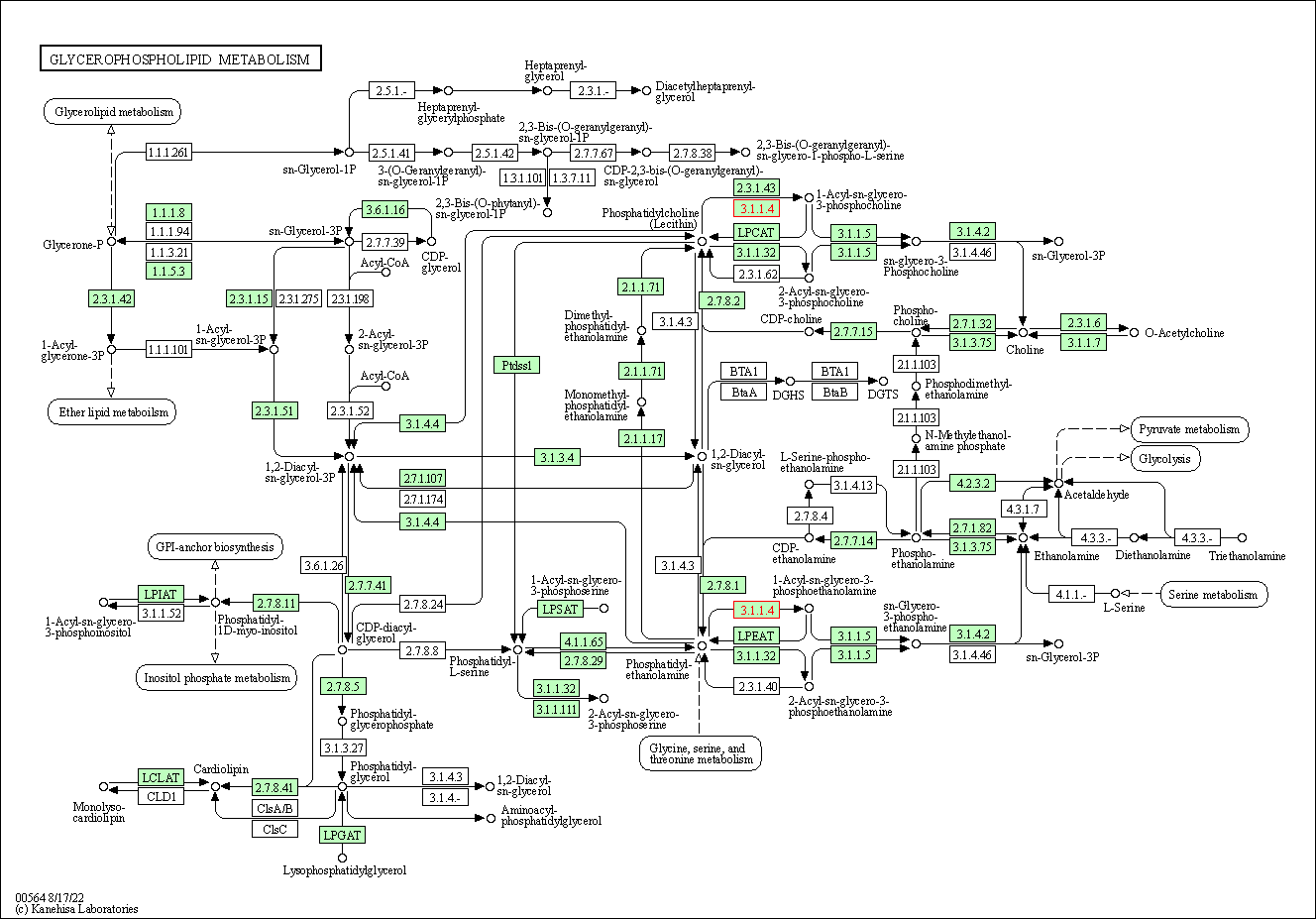
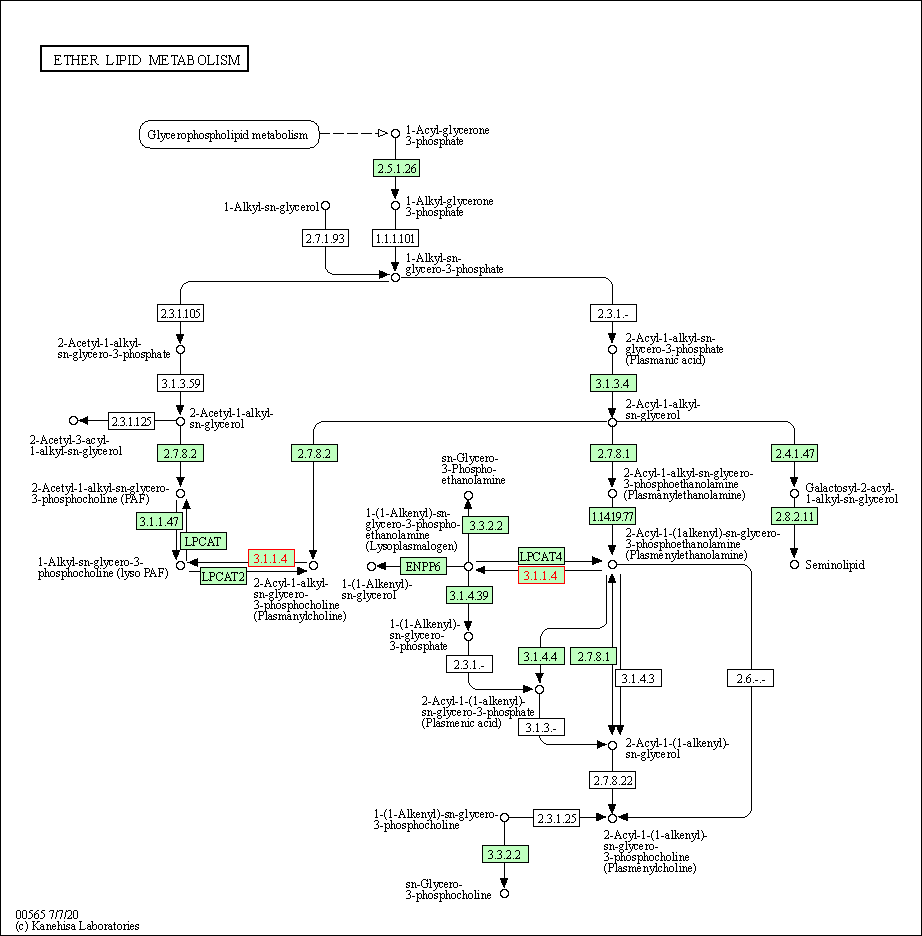
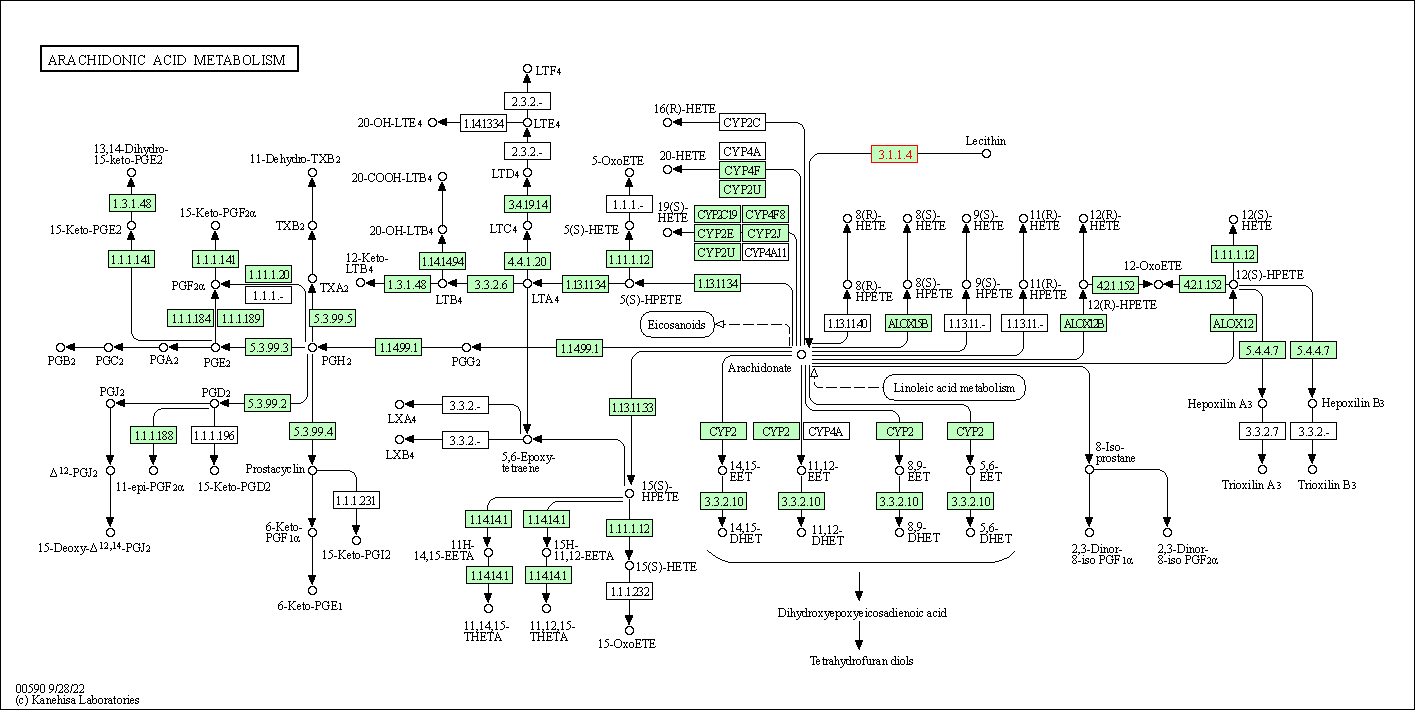
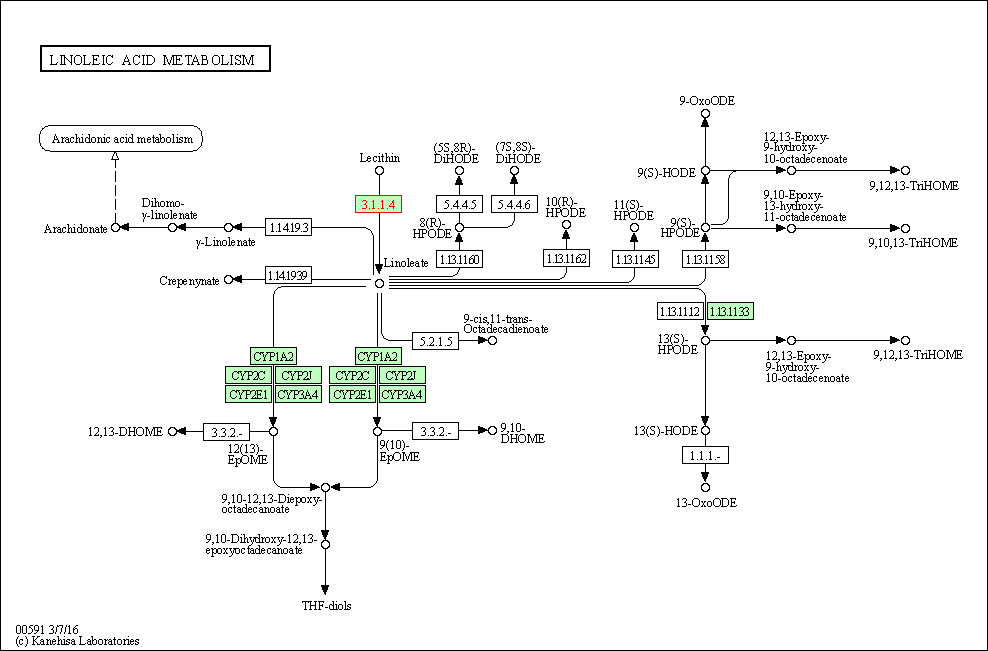
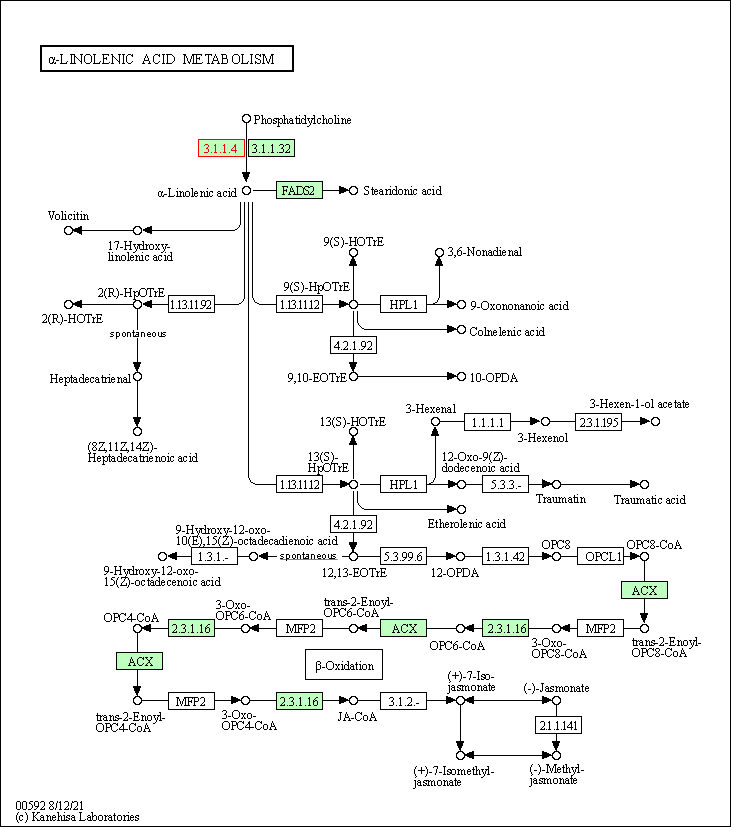
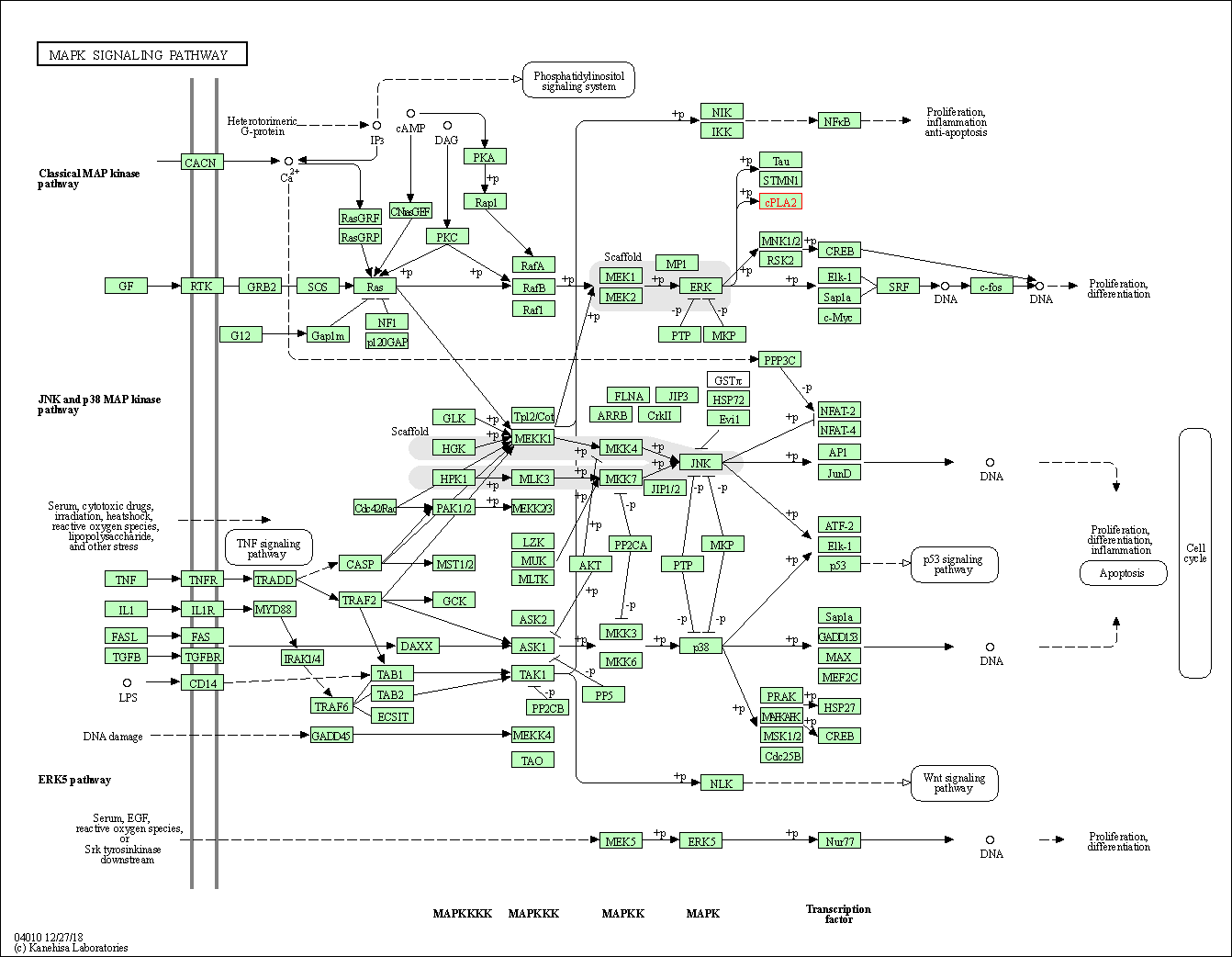
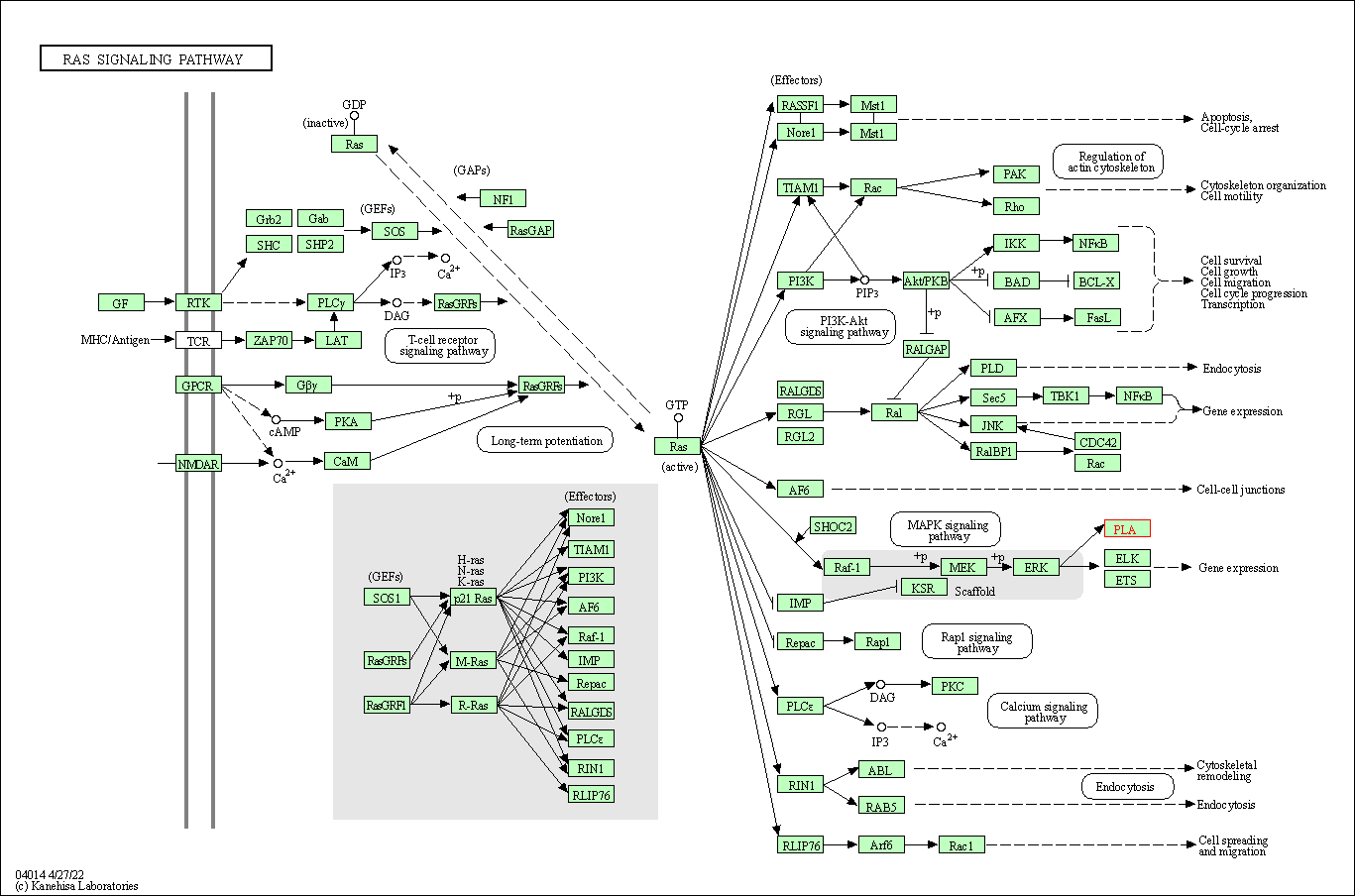
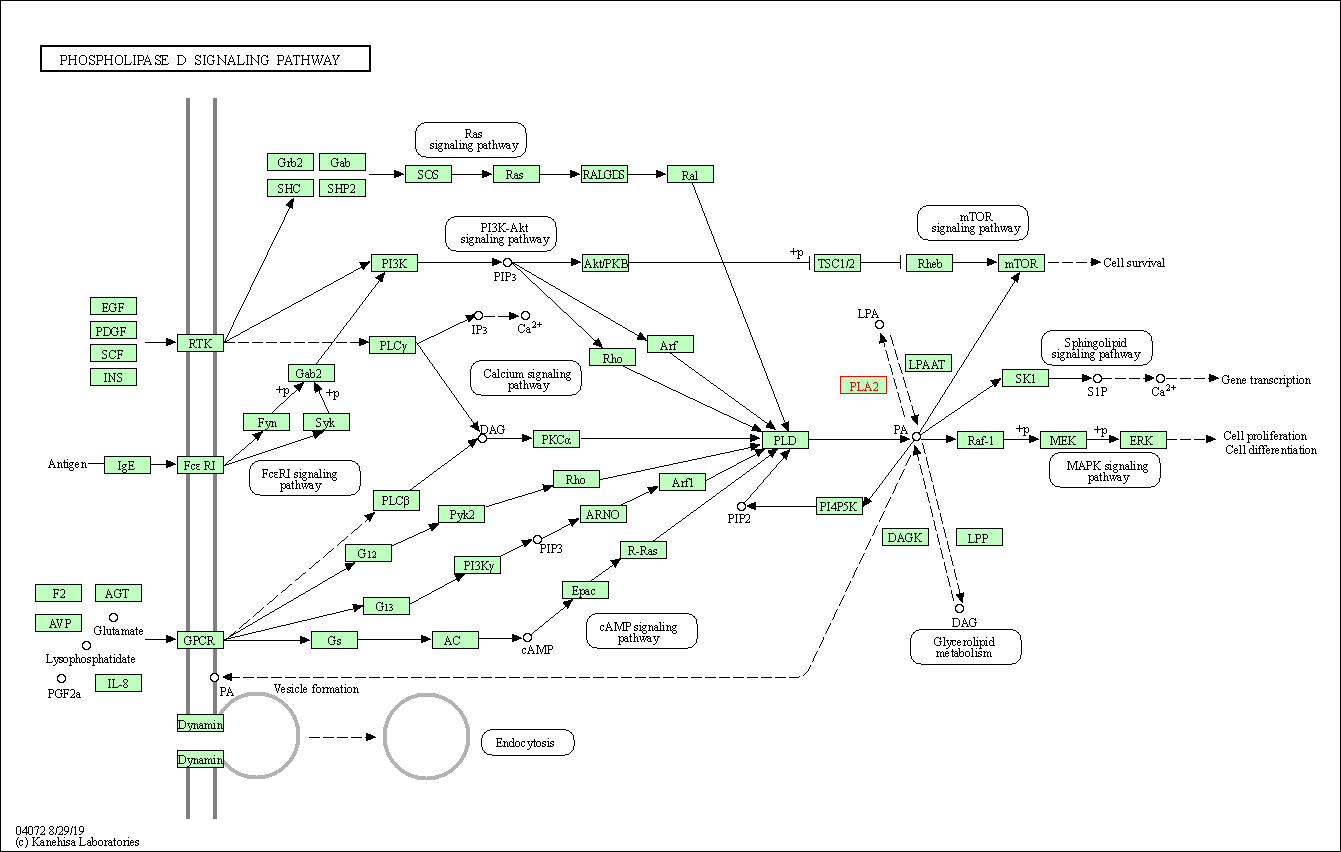
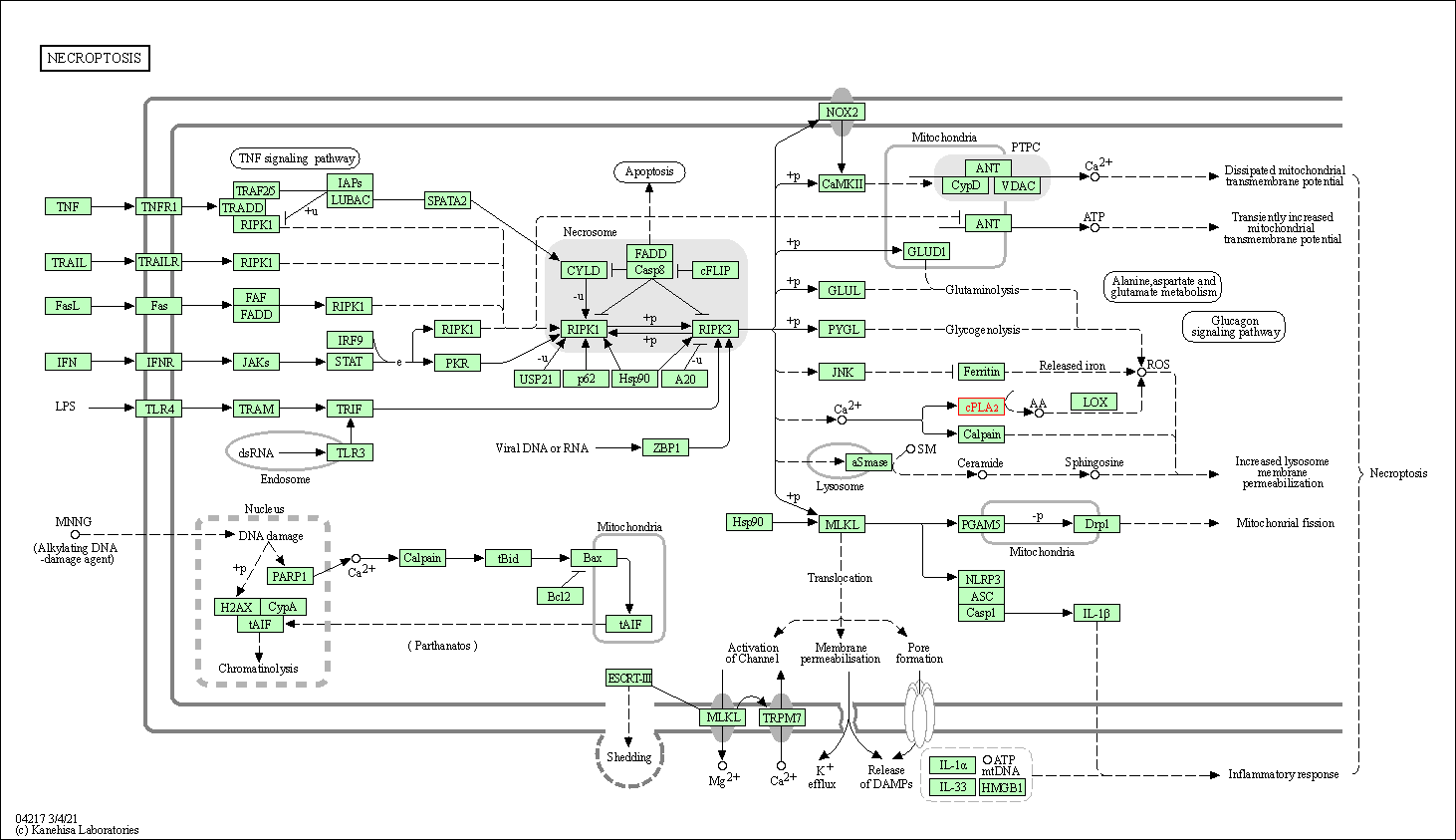
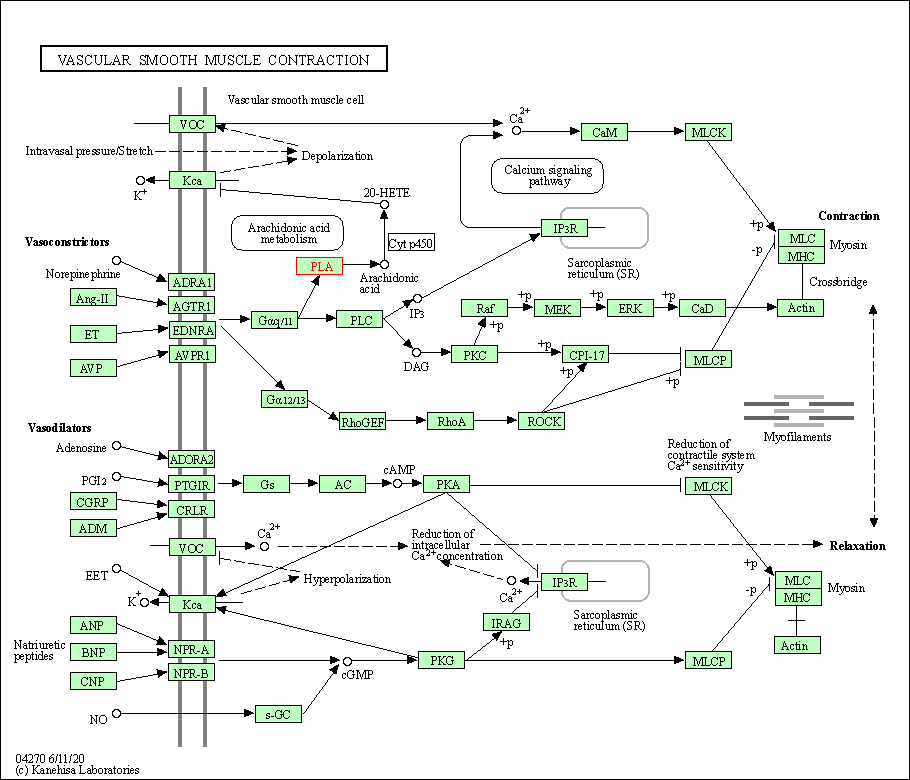


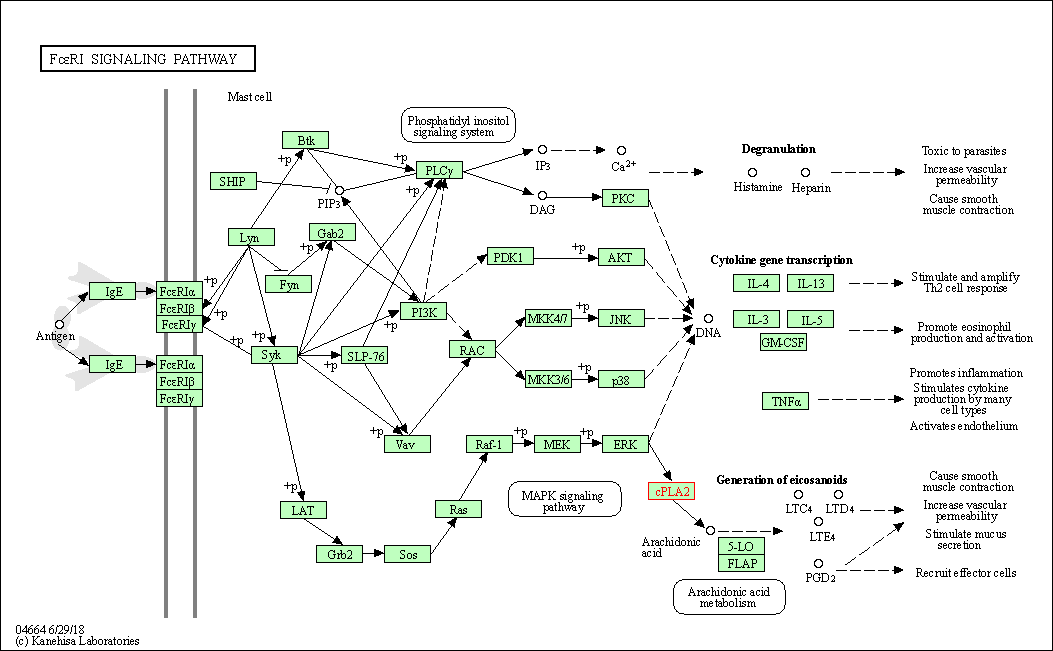

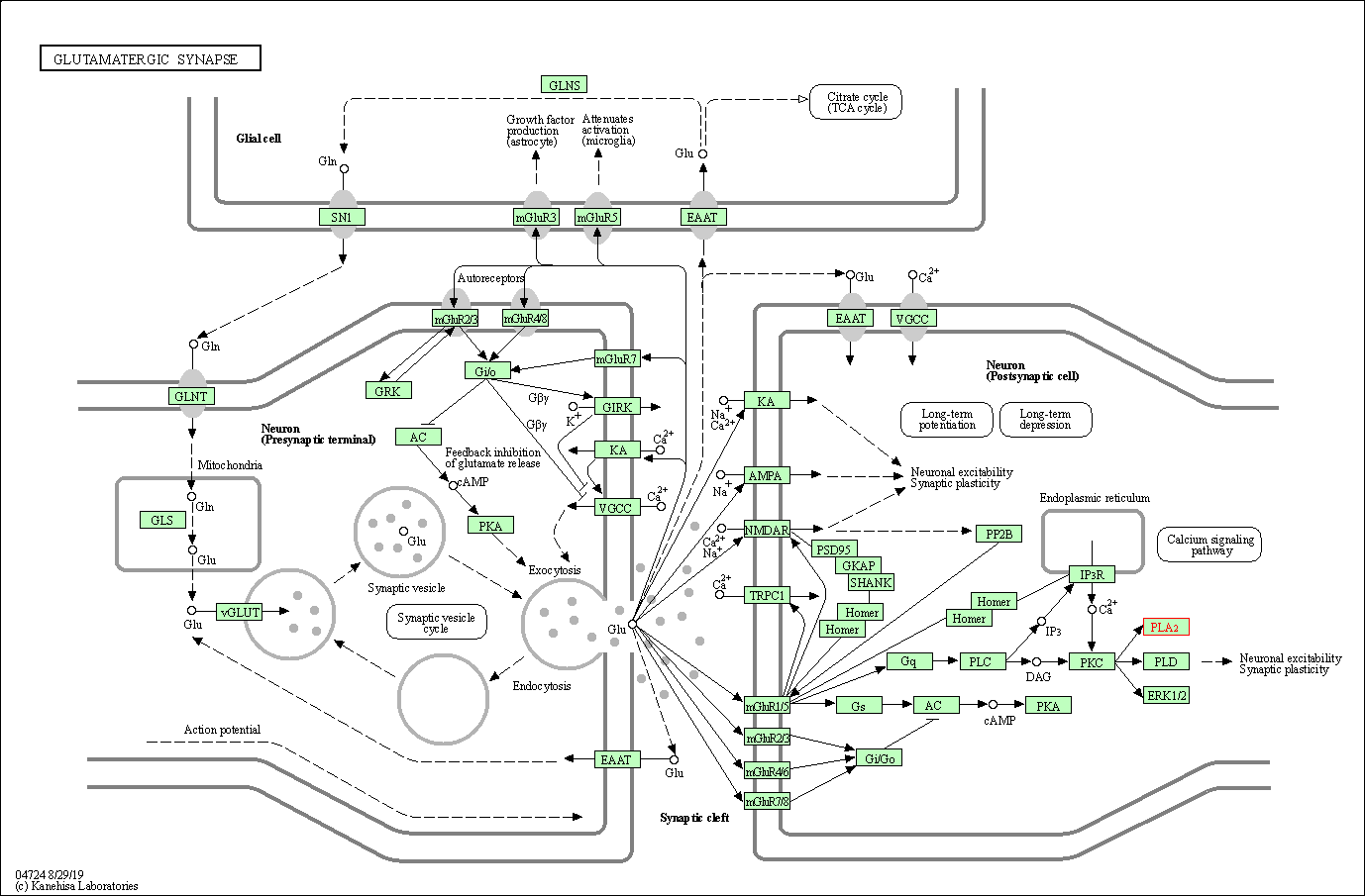
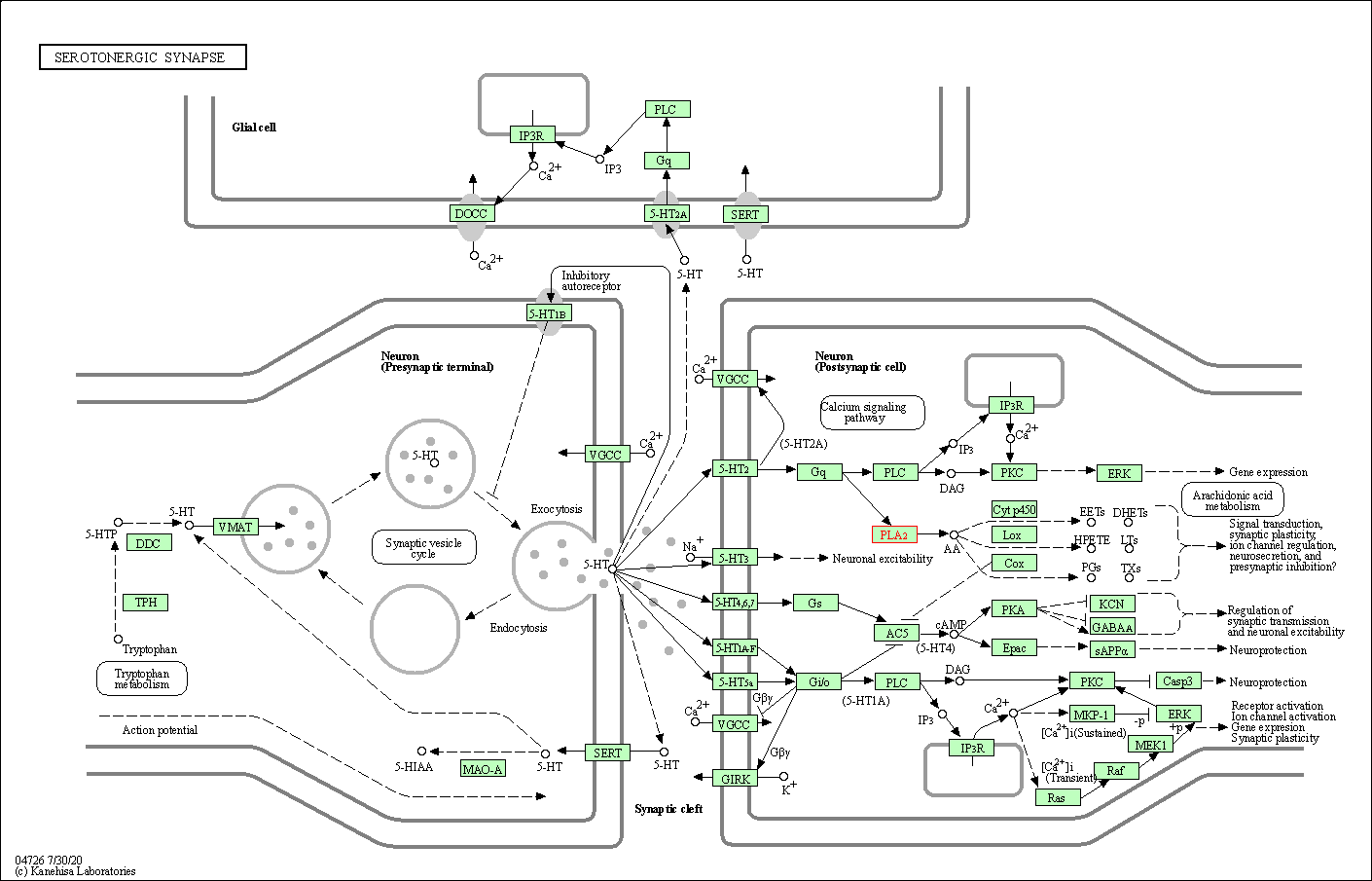
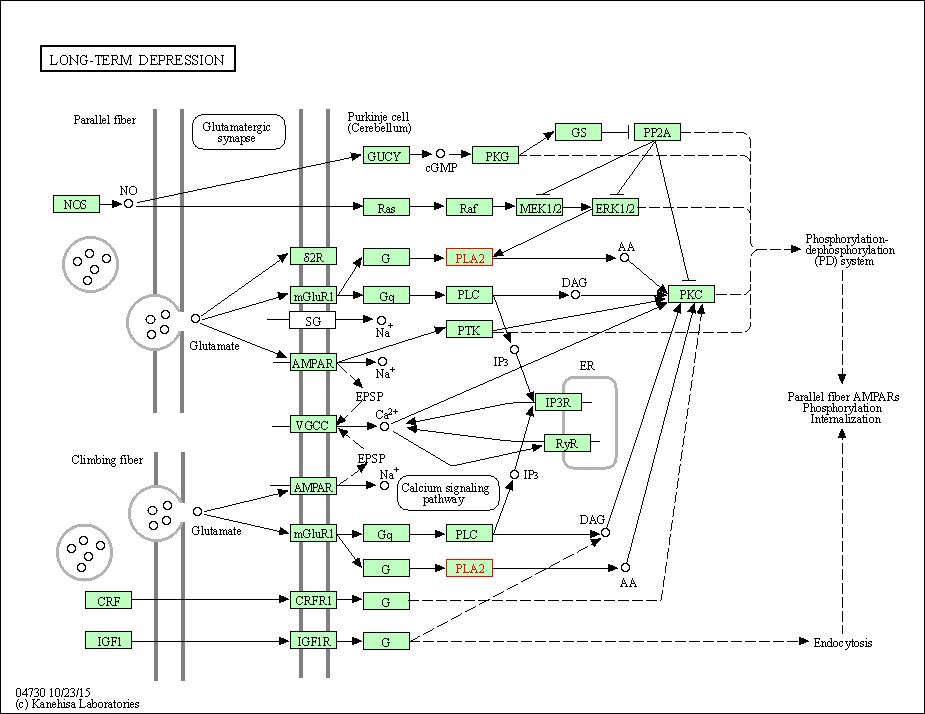



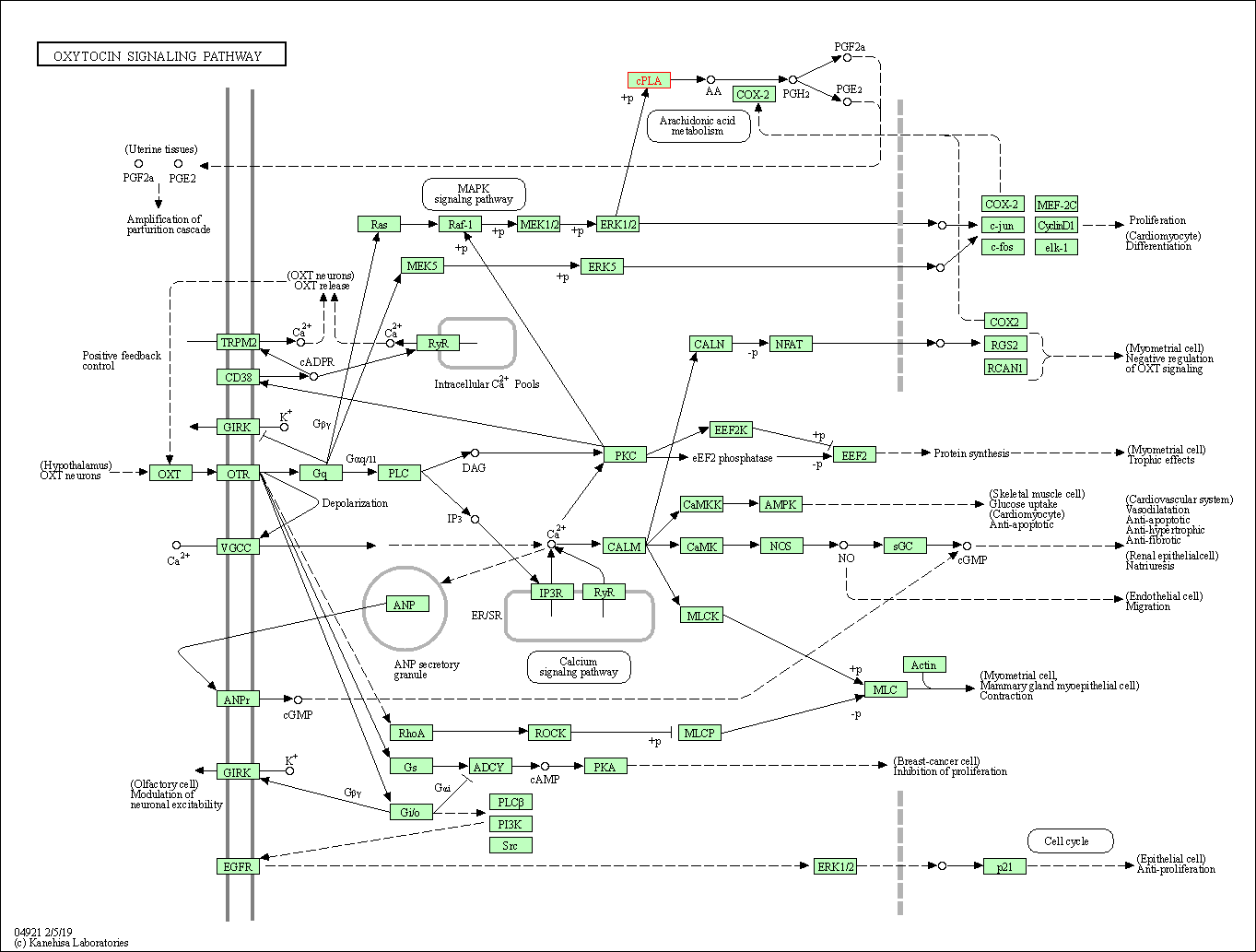
| KEGG Pathway | Pathway ID | Affiliated Target | Pathway Map |
|---|---|---|---|
| Glycerophospholipid metabolism | hsa00564 | Affiliated Target |

|
| Class: Metabolism => Lipid metabolism | Pathway Hierarchy | ||
| Ether lipid metabolism | hsa00565 | Affiliated Target |

|
| Class: Metabolism => Lipid metabolism | Pathway Hierarchy | ||
| Arachidonic acid metabolism | hsa00590 | Affiliated Target |

|
| Class: Metabolism => Lipid metabolism | Pathway Hierarchy | ||
| Linoleic acid metabolism | hsa00591 | Affiliated Target |

|
| Class: Metabolism => Lipid metabolism | Pathway Hierarchy | ||
| alpha-Linolenic acid metabolism | hsa00592 | Affiliated Target |

|
| Class: Metabolism => Lipid metabolism | Pathway Hierarchy | ||
| MAPK signaling pathway | hsa04010 | Affiliated Target |

|
| Class: Environmental Information Processing => Signal transduction | Pathway Hierarchy | ||
| Ras signaling pathway | hsa04014 | Affiliated Target |

|
| Class: Environmental Information Processing => Signal transduction | Pathway Hierarchy | ||
| Phospholipase D signaling pathway | hsa04072 | Affiliated Target |

|
| Class: Environmental Information Processing => Signal transduction | Pathway Hierarchy | ||
| Necroptosis | hsa04217 | Affiliated Target |

|
| Class: Cellular Processes => Cell growth and death | Pathway Hierarchy | ||
| Vascular smooth muscle contraction | hsa04270 | Affiliated Target |

|
| Class: Organismal Systems => Circulatory system | Pathway Hierarchy | ||
| VEGF signaling pathway | hsa04370 | Affiliated Target |

|
| Class: Environmental Information Processing => Signal transduction | Pathway Hierarchy | ||
| Platelet activation | hsa04611 | Affiliated Target |

|
| Class: Organismal Systems => Immune system | Pathway Hierarchy | ||
| Fc epsilon RI signaling pathway | hsa04664 | Affiliated Target |

|
| Class: Organismal Systems => Immune system | Pathway Hierarchy | ||
| Fc gamma R-mediated phagocytosis | hsa04666 | Affiliated Target |

|
| Class: Organismal Systems => Immune system | Pathway Hierarchy | ||
| Glutamatergic synapse | hsa04724 | Affiliated Target |

|
| Class: Organismal Systems => Nervous system | Pathway Hierarchy | ||
| Serotonergic synapse | hsa04726 | Affiliated Target |

|
| Class: Organismal Systems => Nervous system | Pathway Hierarchy | ||
| Long-term depression | hsa04730 | Affiliated Target |

|
| Class: Organismal Systems => Nervous system | Pathway Hierarchy | ||
| Inflammatory mediator regulation of TRP channels | hsa04750 | Affiliated Target |

|
| Class: Organismal Systems => Sensory system | Pathway Hierarchy | ||
| GnRH signaling pathway | hsa04912 | Affiliated Target |

|
| Class: Organismal Systems => Endocrine system | Pathway Hierarchy | ||
| Ovarian steroidogenesis | hsa04913 | Affiliated Target |

|
| Class: Organismal Systems => Endocrine system | Pathway Hierarchy | ||
| Oxytocin signaling pathway | hsa04921 | Affiliated Target |

|
| Class: Organismal Systems => Endocrine system | Pathway Hierarchy | ||
| Click to Show/Hide the Information of Affiliated Human Pathways | |||
| Degree | 2 | Degree centrality | 2.15E-04 | Betweenness centrality | 0.00E+00 |
|---|---|---|---|---|---|
| Closeness centrality | 2.18E-01 | Radiality | 1.38E+01 | Clustering coefficient | 1.00E+00 |
| Neighborhood connectivity | 8.65E+01 | Topological coefficient | 7.86E-01 | Eccentricity | 11 |
| Download | Click to Download the Full PPI Network of This Target | ||||
| Chemical Structure based Activity Landscape of Target | Top |
|---|---|
| Drug Property Profile of Target | Top | |
|---|---|---|
| (1) Molecular Weight (mw) based Drug Clustering | (2) Octanol/Water Partition Coefficient (xlogp) based Drug Clustering | |
|
|
||
| (3) Hydrogen Bond Donor Count (hbonddonor) based Drug Clustering | (4) Hydrogen Bond Acceptor Count (hbondacc) based Drug Clustering | |
|
|
||
| (5) Rotatable Bond Count (rotbonds) based Drug Clustering | (6) Topological Polar Surface Area (polararea) based Drug Clustering | |
|
|
||
| "RO5" indicates the cutoff set by lipinski's rule of five; "D123AB" colored in GREEN denotes the no violation of any cutoff in lipinski's rule of five; "D123AB" colored in PURPLE refers to the violation of only one cutoff in lipinski's rule of five; "D123AB" colored in BLACK represents the violation of more than one cutoffs in lipinski's rule of five | ||
| Target Poor or Non Binders | Top | |||||
|---|---|---|---|---|---|---|
| Target Poor or Non Binders | ||||||
| Target Regulators | Top | |||||
|---|---|---|---|---|---|---|
| Target-interacting Proteins | ||||||
| Target-Related Models and Studies | Top | |||||
|---|---|---|---|---|---|---|
| Target Validation | ||||||
| References | Top | |||||
|---|---|---|---|---|---|---|
| REF 1 | Clinical pipeline report, company report or official report of the Pharmaceutical Research and Manufacturers of America (PhRMA) | |||||
| REF 2 | Indole cytosolic phospholipase A2 alpha inhibitors: discovery and in vitro and in vivo characterization of 4-{3-[5-chloro-2-(2-{[(3,4-dichlorobenzyl)sulfonyl]amino}ethyl)-1-(diphenylmethyl)-1H-indol-3-yl]propyl}benzoic acid, efipladib. J Med Chem. 2008 Jun 26;51(12):3388-413. | |||||
| REF 3 | Reactions of functionalized sulfonamides: application to lowering the lipophilicity of cytosolic phospholipase A2alpha inhibitors. J Med Chem. 2009 Feb 26;52(4):1156-71. | |||||
| REF 4 | Structure-activity relationships of natural and non-natural amino acid-based amide and 2-oxoamide inhibitors of human phospholipase A(2) enzymes. Bioorg Med Chem. 2008 Dec 15;16(24):10257-69. | |||||
| REF 5 | Potent and selective fluoroketone inhibitors of group VIA calcium-independent phospholipase A2. J Med Chem. 2010 May 13;53(9):3602-10. | |||||
| REF 6 | Synthesis of polyfluoro ketones for selective inhibition of human phospholipase A2 enzymes. J Med Chem. 2008 Dec 25;51(24):8027-37. | |||||
| REF 7 | 1-Indol-1-yl-propan-2-ones and related heterocyclic compounds as dual inhibitors of cytosolic phospholipase A(2)alpha and fatty acid amide hydrolase. Bioorg Med Chem. 2010 Jan 15;18(2):945-52. | |||||
| REF 8 | Discovery of Ecopladib, an indole inhibitor of cytosolic phospholipase A2alpha. J Med Chem. 2007 Mar 22;50(6):1380-400. | |||||
| REF 9 | 85-kDa cPLA(2) plays a critical role in PPAR-mediated gene transcription in human hepatoma cells. Am J Physiol Gastrointest Liver Physiol. 2002 Apr;282(4):G586-97. | |||||
| REF 10 | 2-Oxoamide inhibitors of phospholipase A2 activity and cellular arachidonate release based on dipeptides and pseudodipeptides. Bioorg Med Chem. 2009 Jul 1;17(13):4833-43. | |||||
| REF 11 | Inhibitory effect of synthetic C-C biflavones on various phospholipase A(2)s activity. Bioorg Med Chem. 2007 Nov 15;15(22):7138-43. | |||||
If You Find Any Error in Data or Bug in Web Service, Please Kindly Report It to Dr. Zhou and Dr. Zhang.

